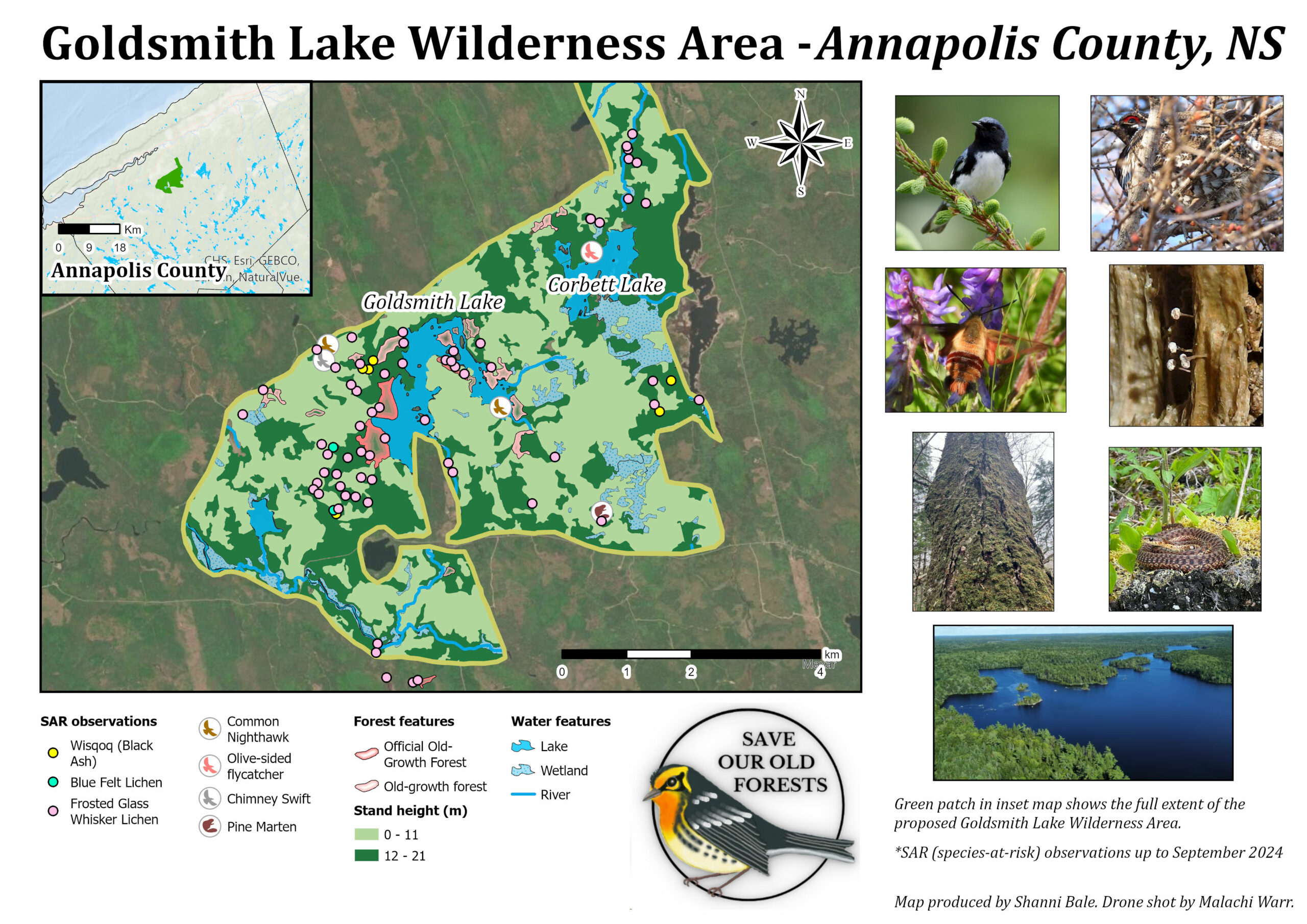The Jewel of Annapolis County

Goldsmith Lake is the largest lake in the Round Hill River watershed, a sub watershed of the Annapolis River. Unlike many of the other lakes in the area Goldsmith has not been dammed for hydroelectricity or water supply. Neither Goldsmith nor Corbett Lake to the east have been developed for summer or permanent homes, being formerly Bowater lands and now Crown.
The forests surrounding these two lakes are known to biologists, ecologists and interested residents of the area as being healthy, particularly rich in biodiversity, and relatively unspoiled by roads and logging. Almost nowhere in Nova Scotia is untouched. This area is some of the very best of what we do have.
The Citizen Scientists of Southwest Nova Scotia submitted a proposal to the Protected Areas Branch (Environment and Climate Change) to protect an area of 3900 ha of Crown land surrounding Goldsmith Lake. The original proposal was submitted in November 2022. Since that time there has been a lot of exploration done in the area which has confirmed identification of 95 occurrences of Species At Risk, and discoveries of previously unidentified areas of forests that meet the criteria of “Old Growth” and have been reported to the Department of Natural Resources.
If it were to be designated “protected” the Goldsmith Lake Wilderness Area would include both Goldsmith and Corbett lakes, as well as headwaters of the Round Hill River, and Tupper Brook, patches of recognised old growth and other areas of high conservation value old forest.
Proposal To protect
The Citizen Scientists of Southwest Nova Scotia originally submitted a proposal to the
Minister of Environment and Climate Change in November 2022 to protect the Goldsmith Lake area in Annapolis County as part of the 20% by 2030 target.
The proposal was updated in May 2024 to incorporate observations that had been documented over the course of 18 months.
The updated proposal included a request that the Goldsmith Lake Wilderness Area area be placed under consideration for protection as part of the 1.35% of Nova Scotia that will be protected by March 2026 to meet the 15% interim target.
Species at risk (SAR) at Goldsmith
Citizen Scientists have identified, confirmed and reported sightings of the following SAR in the forests around Goldsmith Lake. Check the Intro to Lichens page to learn more about the role these fascinating organisms play in the ecosystem of forests and what they can tell us about the environment.
- Blue felt lichen (Pectenia plumbea)
- Frosted glass-whisker lichen (Sclerophora peronella)
- Black foam lichen (Anzia colpodes)
- Wisqoq or Black ash (Fraxinus nigra)
- Common nighthawk (Chordeiles minor)
- Chimney swifts (Chaetura pelagica)
- Olive-sided flycatcher (Contopus cooperi)
- Rusty blackbird (Euphagus carolinus nigrans)

Photo Credit: Ashlea Viola
In addition to the SAR that have been documented and confirmed, the endangered species American Marten (Martes americana) was observed and reported within the borders of the Goldsmith Lake Wilderness Area. The American Marten has been declared a Species at Risk in Cape Breton, this Marten is apparently about to be declared at risk in the whole province. It has been observed and reported within the Goldsmith Lake Wilderness Area.
Join the Goldsmith Lake Wilderness Area project on iNaturalist!

Join Friends of Goldsmith Lake Wilderness Area on Facebook!

